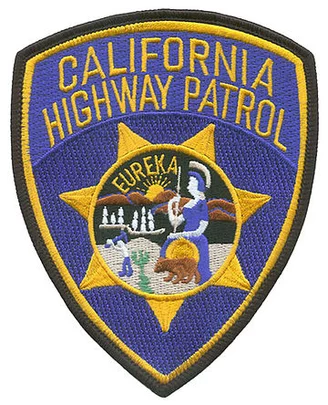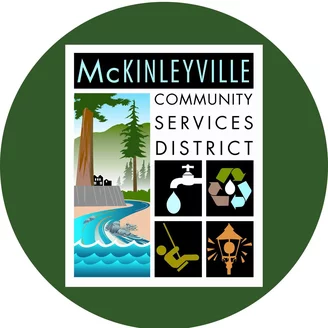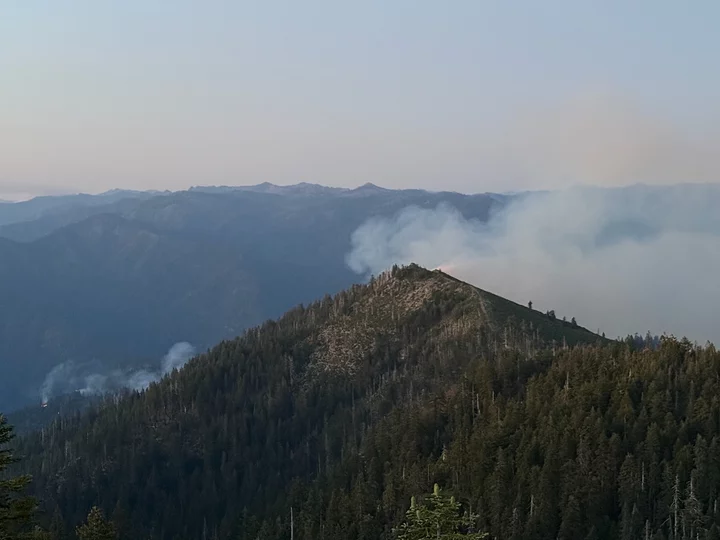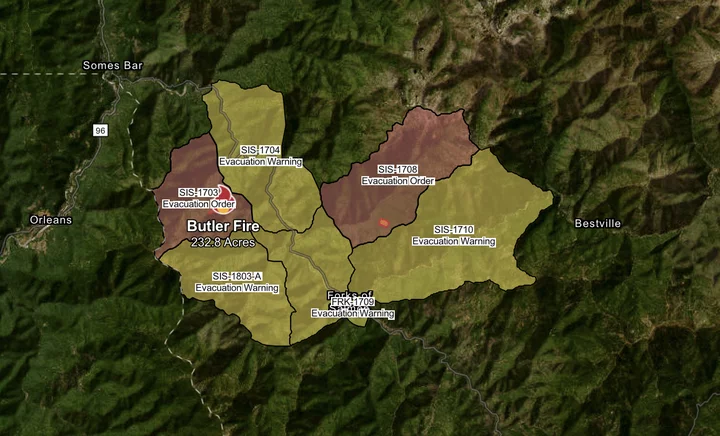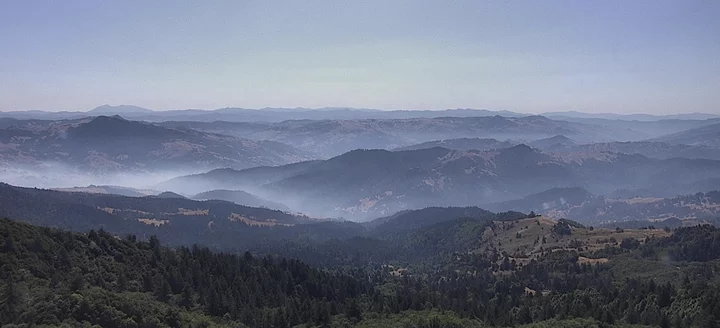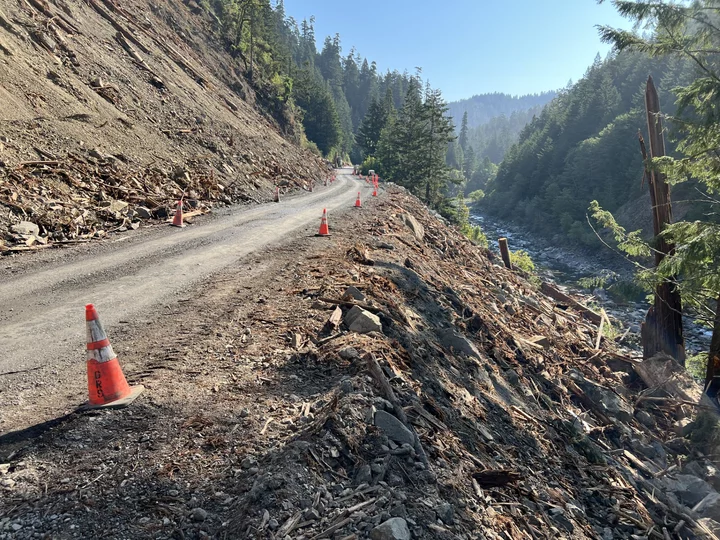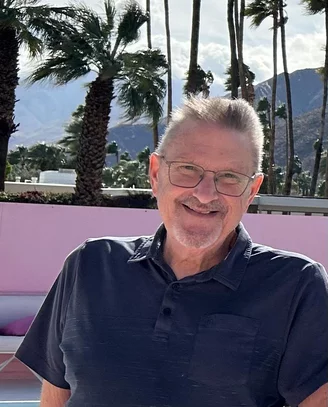CHP Corrects the Record on Last Week’s Incident Involving a Local Man Being Bitten by an Injured Bear
Isabella Vanderheiden / Monday, July 7 @ 4:42 p.m. / Traffic
###
As it turns out, the man who was bitten by the injured black bear on Highway 299 last week was not the same driver who injured the animal in the first place.
California Highway Patrol Sgt. Caleb Carey contacted the Outpost this afternoon to correct some “partially incorrect” information that was provided to us last week by a spokesperson with the California Department of Fish and Wildlife (CDFW). Carsey said he had “reached out to CDFW to ensure they were disseminating the most accurate information possible,” but there was an apparent miscommunication.
“The party that was injured by the bear was not the driver who struck the bear. He was simply a passerby who stopped and attempted to assist the injured animal,” Carsey wrote via email. “I bring this up only because he is clearly very passionate about bears, and I fear he’ll be offended by statements that he hurt one.”
At this point, Carsey said investigators can only speculate that the bear was injured in the vehicle collision, adding that there “appears to be no other plausible mechanism of injury.”
“[N]o physical evidence was located on scene to suggest a vehicle was involved, no leads were discovered to investigate, and no one has come forward to admit their involvement,” he said. “As such, we have closed our investigation into the incident.”
Asked about the current condition of the 59-year-old man who was bitten by the bear, Carsey said he hadn’t spoken to him since the day after the incident, at which point he was still “hospitalized due to his injuries.” He added that the man was only bitten once, not “multiple times,” as previously reported.
BOOKED
Yesterday: 6 felonies, 8 misdemeanors, 0 infractions
JUDGED
Humboldt County Superior Court Calendar: Today
CHP REPORTS
No current incidents
ELSEWHERE
RHBB: Fire Crews Brace for Heat as Butler Fire Threatens Salmon River Road
RHBB: Meredith Matthews Named Executive Director of Humboldt Lodging Alliance
RHBB: Cal Poly Humboldt Launches Media Arts BFA a Year Early, Merging Tech and Creativity
RHBB: Major Roadwork Scheduled Friday, July 11 through Thursday, July 17
Beloved McKinleyville Log Stolen
LoCO Staff / Monday, July 7 @ 4:14 p.m. / Feel Sad
Come home, wood | McKinleyville Community Service District
McKinleyville Community Services District release:
This natural sculpture centerpiece at the Botanical Garden in Hiller Park has recently gone missing. It was last seen before the July 4th weekend and its disappearance was noticed shortly after.
This unique piece has been a special part of the garden, and we’re hoping someone in the community may know what happened to it.
If you have any information about its whereabouts, please contact the McKinleyville Parks & Recreation Department. Thank you for helping us keep our parks beautiful and welcoming for all!
FIRE UPDATE: Butler Fire Grows to 233 Acres With Zero Containment, Prompting Mandatory Evacuations; Evacuation Warnings Lifted for Bridge Fire Near Alderpoint
Isabella Vanderheiden / Monday, July 7 @ 11:42 a.m. / Fire
View of the Butler Fire from Orleans lookout. | Photo: Six Rivers National Forest
###
Northern California fire crews are responding to two wildfires burning along the Humboldt County line — the Butler Fire near Forks of Salmon in Siskiyou County and the Bridge Fire near Alderpoint. The following fire updates are current as of this morning.
Butler Fire
The Butler Fire, which ignited near Forks of Salmon during a lightning storm on Thursday evening, has grown to 233 acres with no containment. There are 73 fire personnel assigned to the fire, including four crews, four engines and two helicopters, with a fixed wing on order.
There is a mandatory evacuation order in place for Siskiyou County residents living in SIS-1703 and SIS-1708. There are evacuation warnings in place for SIS-1704, SIS-1707, SIS-1710 and SIS-1803-A. Click here for an interactive map of current evacuation orders.
A map of evacuation orders and warnings for the Butler Fire. | Screenshot
The following information comes from the Six Rivers National Forest:
Leader’s Intent: The Butler Fire is being managed with a full suppression strategy emphasizing firefighter and public safety.
Operational Update: Last night, hotshot crews successfully conducted 2 miles of defensive firing operations using pre-existing line, trails, and rock features to remove unburnt fuels below the ridgetop Boundary and Orleans Mountain Trails to secure line and hold the fire within the Lewis Creek drainage. Conditions were favorable for operations that assisted in meeting containment objectives without putting firefighters and critical values at risk.
The daytime marine influence moderated fire behavior and gentle evening winds pushed fire back down into Lewis Creek drainage. This operation helped protect the ridgeline from high-severity fire by reducing fuels up to 20 feet from the ridgetop in brush and 100 feet in timber. Conditions permitting, firefighters may continue to use nighttime defensive firing operations in coming days to help strengthen fire lines and moderate fire behavior.
Using firing operations and pulling back to natural barriers, such as the pre-existing containment features from previous fires, ridgetops, trails, roads, and rivers may increase fire size, but greatly reduces engagement risks. Firefighter and public safety remain the highest priority. Incident leadership is also committed to minimizing fire size and will be applying full suppression tactics.
Today, Nordheimer and Butler Structure groups will continue with structure protection. Orleans Mountain Lookout protection will also be a key focus. Crews plan to scout and prep from Nordheimer Campground up to the Boundary and Orleans Mountain Trails to link up with crews holding last night’s progress on the ridgetop. Until yesterday, air resources had been shared with other incidents across the north state, but the Butler Fire secured 2 helicopters for full-time air operations.
Strategic Objective: The Butler Fire is currently burning in a remote location through steep terrain (slopes up to 90%) riddled with snags and heavy brush. The area also holds considerable value to the local community. Access to the fire area is extremely difficult. There are no direct roads to the fire, and the sole ingress-egress for the communities of Forks of Salmon and Somes Bar and firefighters is the Salmon River Road. Leadership is strategically adapting tactics as weather and fire conditions evolve.
Closures & Evacuations: An Evacuation Order has been issued for SIS-1703 (no residents). Warnings are now in place for zone SIS-1704 (Butler Creek, Lewis Creek, Bloomer Mine residents and Nordheimer Campground), SIS-1707, and SIS 1803-A (no residents). There are currently no planned road closures or delays along Salmon River Road. However, local residents are advised to slow down and use caution with the increased firefighter presence in the area. Despite the Evacuation Warning, Nordheimer Campground remains open. Campers should monitor the situation and be prepared for conditions to change.
Weather & Fire Behavior: There is a 20% chance of dry thunderstorms this afternoon. Temperatures will be in the high 90s with northeast winds 5 to 7 mph. Fire behavior is moderate on ridgetop but changes as it slowly backs downslope through brush and timber in the Lewis Creek drainage.
Fire Safety & Prevention: While the Six Rivers National Forest is not currently under fire restrictions, firefighters are working on multiple incidents locally and across Northern California. Help firefighting resources focus on current incidents by preventing new ones. Please use caution with anything that can spark a fire when working or playing in the woods. Report suspected wildfires by calling 911.
Fire Information: For additional information and fire information resources visit www.linktr.ee/srffirepio.
###
Looking southeast from Pratt Mountain. | Image via UC San Diego California Alert.
Bridge Fire
The Bridge Fire, burning on both sides of the Eel River near Alderpoint, has grown to 348 acres with roughly five percent containment. Evacuation warnings for the fire were lifted just after 11:30 a.m.
CalFire hasn’t provided additional information about the current fire response as of this writing, but a previous update indicates the fire is burning at a “moderate rate” with air and ground resources focused on protecting nearby structures.
###
Dozens more wildfires are burning across California. More information about those fires can be found here.
Highway 36 is Open, But There May Be Some Big Delays For Travelers This Week
LoCO Staff / Monday, July 7 @ 11:22 a.m. / Traffic
Caltrans
Caltrans release:
Route 36 is now open to one-way traffic east of Swimmer’s Delight near Grizzly Creek Redwoods State Park. Travelers should be prepared for delays and drive through the slide area with caution.
Beginning Tuesday, July 8, weekday traffic delays of up to two hours will occur between 9 a.m. and 5 p.m. as crews continue work on slope stabilization and build a temporary lane farther from the hillside. Openings through the work zone will take place at the top of the hour at 11 a.m., 1 p.m., 3 p.m., and 5 p.m. — the same schedule used during previous work in this area.
Travelers should plan to arrive at the slide about 10 minutes before scheduled opening times.
Outside of those hours, when no active construction is scheduled, vehicles will be escorted through the area in small groups for safety. Delays will depend on traffic volumes and are difficult to predict, but 30 minutes is a reasonable estimate.
This schedule is likely to remain in place for several weeks. We’ll share any updates as soon as they’re available.
Cleaning Up Smog Is Suddenly Much Harder. Reined in by Trump, What Will California Do Next?
Alejandra Reyes-Velarde / Monday, July 7 @ 7 a.m. / Sacramento
This story was originally published by CalMatters. Sign up for their newsletters.
###
At an electric vehicle showcase in Anaheim, Christopher Grundler — one of the top executives in California responsible for cleaning the air — said despite all the setbacks his agency has faced this year, he’s confident the state can keep making progress.
“This president, this Congress, will not kill the electric car,” said Grundler, a deputy executive officer of the state Air Resources Board. “They won’t kill the electric truck, and they certainly won’t kill the California spirit.”
Despite that optimism, California officials — now reined in by the Trump administration and growing concerns about affordability and costs — are struggling to come up with new ways to clean up the nation’s most polluted air.
Lacking federal permission to set aggressive emission standards for the first time in almost 60 years, California may be left mainly with voluntary agreements with the auto, trucking and rail industries, and subsidies to entice consumers into buying electric vehicles.
Congress last month revoked the state’s authority to implement three landmark rules that ban sales of new gas-powered cars by 2035 and phase out diesel trucks. In addition, California was forced to abandon four other ambitious rules for zero-emission trucks, locomotives and commercial harbor craft because the Trump administration’s Environmental Protection Agency would be unlikely to grant waivers.
Those seven mandates, now unenforceable, were key to cleaning up the pollutants that leave about 34 million Californians regularly breathing unhealthy air. In another blow to California’s efforts, Congress and President Donald Trump eliminated tax credits for consumers who buy electric cars.
At the same time, California’s air quality rules are facing growing pushback from the public, industry — and even some Democrats in the Legislature — because of the impacts on gas prices and other economic concerns.
Air Resources Board Chair Liane Randolph, in an interview with CalMatters, did not offer any details on how the agency will make up for the voluminous tons of smog-causing gases and soot those rules would have eliminated.
“There’s no one strategy that’s going to work. It’s really going to need to be a suite of different things,” Randolph said. The governor and Legislature will help decide “what strategies are going to be the most effective, the most cost effective, the most likely to be able to scale up,” she said.
The air board is hosting four meetings in the coming weeks to hear ideas from industry groups, environmentalists and community members about how the state should now approach clean air regulation.


First: A zero-emission heavy-duty truck shown at an exhibition in Anaheim. Last: Fernando Silva with TEC equipment test drives a Volvo electric truck. Photos by Jules Hotz for CalMatters
In an executive order last month, Gov. Gavin Newsom directed the air board to develop a new zero-emission car mandate — apparently in preparation for when the state either wins its lawsuit against Trump or when he leaves office.
Newsom also ordered the air board to develop a plan by Aug. 11 to keep expanding California’s market for electric cars and trucks. As part of the plan, the state agency must consider ways to improve charging infrastructure and offer incentives.
“We know that the federal government is going to be completely useless in our efforts to clean the air, despite rhetoric claiming they care about clean air. State and local governments are going to have to do more,” said Adrian Martinez, an attorney with the San Francisco-based environmental group Earthjustice.
“We just have to go it alone.”
Heart and lungs at stake
It’s been a long, bumpy road to cleaning up exhaust from California’s 36 million vehicles. Gas-powered cars and diesel trucks remain the state’s largest sources of smog and soot despite decades of cutting emissions.
Much of that pollution is inhaled by the most vulnerable Black and brown communities near ports, highways and warehouses. Ozone, a smog-causing gas, and fine particles of soot are linked to premature deaths from heart attacks and respiratory diseases, and increased emergency room visits.


For six decades, a provision in the Clean Air Act has granted California the power to set its own vehicle standards that are stricter than the federal government’s because of the state’s unique and severe air pollution problem.
But last month, Congress invoked the Congressional Review Act to repeal waivers granted by the Biden administration. The state in its lawsuit called this an unlawful action by Congress.
John Dunlap III, who served as California Air Resources Board chair under Gov. Pete Wilson in the 1990s, said in an interview with CalMatters that the Newsom administration “pushed too fast, and I think there were some holes” in their zero-emission car and truck rules.
Dunlap said by moving forward despite concerns about inadequate charging infrastructure, cost and the impacts on trucking, California regulators sent their critics straight into the arms of a more sympathetic federal government.
“They’ve been all in on zero-emission technology, which is great. It’s been a priority. But, they haven’t really cared to dialogue much, if at all, with the users of technology, particularly truck fleets,” he said. Dunlap was chair in 1996 when the board repealed deadlines requiring sales of electric cars because the technology wasn’t ready.
Under the landmark rule adopted by the air board in 2022, all new cars sold in California would have to be zero emissions beginning with 2035 models, ramping up from 68% in 2030. For trucks, California enacted two rules, one in 2020 and then one in 2023 that would phase out new diesel trucks by 2042. None will now be implemented.

A fast-charging station in Union City. Photo by Loren Elliott for CalMatters
Automakers say the rules were too aggressive and would have led to manufacturing job losses, higher car prices and limited consumer choices.
“The auto industry has invested billions in electrification and has 144 electrified models on the market right now. Again, the concerns were about the mandate – not the technology,” the Alliance for Automotive Innovation said in a statement.
Conservatives say the air board is an unelected board that wields too much power. (Its members include appointees from Newsom and the Legislature, and local elected officials.) A Democrat in the Legislature last month urged Randolph, the board’s chair, to resign because the agency hasn’t analyzed the economic costs of its rules.
One new clean-air rule, the revamped Low Carbon Fuel Standard implemented last week, was met with widespread, vehement criticism from elected officials and industry since it will raise the price of gasoline by an unknown amount.

Christopher Grundler, the California Air Resources Board’s deputy executive officer of mobile sources and incentives, delivers opening remarks at a zero-emission vehicle showcase in Anaheim. Photo by Jules Hotz for CalMatters
Amid concerns about the costs to consumers, the Trump administration and industry groups also are making it difficult for local agencies to take bold action.
The South Coast Air Quality Management District — responsible for regulating industrial plants and products that pollute the LA basin’s air — recently rejected rules phasing in zero-emission water heaters and furnaces.
The rules would have brought one of the biggest pollution reductions that the district has implemented in decades. But business groups and others were strongly opposed, saying fees imposed on manufacturers would raise the cost of products. And U.S. Attorney Bill Essayli threatened the local air district with a lawsuit if it approved the rule.
South Coast district Board Chair Vanessa Delgado and Executive Officer Wayne Nastri rejected multiple requests for interviews with CalMatters about what they plan to do next to clean the air in the LA basin.
“As you know, 80% of emissions in our region come from mobile sources — planes, trains, ships, heavy-duty trucks — all of which we do not have federal regulatory authority over,” said Nahal Mogharabi, spokesperson for the agency.
She directed all questions to Trump’s EPA.
What else can the state do?
Last month at the clean-vehicle showcase in Anaheim, Brett Ivy, a fleet manager for the aerospace company Northrop Grumman, wandered through Angel Stadium’s parking lot, looking at electric trucks and machines that he could potentially buy for his company.
Ivy knows the state isn’t enforcing its truck mandates, so he doesn’t know what his bosses will direct him to do in the future. He said they could abandon electric vehicles altogether.
But Ivy added, who knows what the next administration would bring, and Northrop Grumman has to think long-term. He wants to be prepared to do his job managing the company’s fleet of trucks.
“If we don’t, a new administration might reverse what (Trump) did,” he said. “Then you’re behind.”
The trucking industry, when the mandate was approved in 2023, predicted economic chaos and dysfunction and that it would “fail pretty spectacularly.” With its repeal, Nick Chiappe of the California Trucking Association expects that fleet owners will keep buying hydrogen and electric trucks when it makes economic sense, such as with smaller vehicles with shorter hauls.
“The industry will continue to work with (the air board) on reasonable steps to advance zero-emissions technology but maintain that the programs being rolled back were infeasible from the moment they were proposed,” Chiappe said.

A zero-emission loader shown at Angel Stadium. Construction equipment powered by diesel is a major source of air pollution. Photo by Jules Hotz for CalMatters
Experts and advocates say California will have to approach clean air policy from many angles — mandates and incentives.
“There is still work that can be done,” said Martinez of Earthjustice. It’ll require “being creative and not losing steam,” he said. “These are big hits (from Trump) but I think still continuing to press on zero-emission vehicles is going to be really critical.”
Craig Segall, a former deputy executive officer for the state Air Resources Board, said the state should set new standards for cars and trucks. “The only thing that EPA is barred from doing is issuing substantially the same – not similar – waivers in the future,” he said. “The state can actually do quite a lot in terms of new standards.”
Segall said the state also should support companies that have already been buying zero-emission trucks with financing programs and get at the root of the transportation problem by expanding mass transit.
“There’s a wide array of things that the state could do to make it clear that they don’t wish to continue having gasoline cars sold in the state of California.”
— Mary Nichols, former chair of the Air Resources Board.
Offering incentives to consumers buying clean cars and trucks will be key. But Grundler, when asked whether California has the funds for more incentive programs, answered bluntly: No.
The state’s Greenhouse Gas Reduction Fund, paid for by its cap and trade market program, typically has around $4 billion for programs related to climate change and air pollution. But because of the large deficit this year, the new budget allocated about $1.5 billion of those cap and trade funds to Cal Fire for fire prevention. It’s unclear how much will be left over for other projects.
In the state’s new budget, $132 million is allocated over the next fiscal year for an air board program offering incentives to truck fleet buyers.There also are creative ways that the state can encourage the purchase of electric cars, said Mary Nichols, the longtime chair of the air board under two previous governors and Newsom. Registration fees or sales taxes could be based on whether a car is gas-powered or electric, she said.
“The state of California has authority over everything relating to what cars can operate on our roads, as long as we’re not violating any constitutional requirements that deal with commerce between the states,” Nichols told CalMatters. “There’s a wide array of things that the state could do to make it clear that they don’t wish to continue having gasoline cars sold in the state of California.”
Tackling ‘pollution magnets’
Experts say one of the most impactful policies the state could pursue without federal intervention could be regulating “pollution magnets.” These are hotspots, such as warehouses, ports and airports, that don’t directly pollute, but draw high-polluting vehicles, like diesel trucks and trains into communities.
Polluting ports, airports and warehouses “should be held responsible for the air pollution that’s released into these neighborhoods because of their operations.”
— Brennon Mendez, UCLA School of Law
The South Coast Air Quality Management District is developing a rule that would push the Los Angeles and Long Beach ports to install more charging stations for zero-emission trucks and cargo handling equipment. The district also approved a rule for warehouses that environmentalists call a success. These are known as “indirect source rules” since they regulate a place that is a hotspot.
These types of regulations “are definitely a leading strategy that California can continue to pursue environmental justice goals, despite the federal government being completely disinterested in environmental justice,” said Brennon Mendez, an environmental law and policy fellow at UCLA School of Law.
Polluting ports, airports and warehouses “should be held responsible for the air pollution that’s released into these neighborhoods because of their operations,” he said.

An electric backhoe loader forklift on display at the Anaheim showcase. Zero-emission equipment like this could replace diesels, which emit fine particles of soot. Photo by Jules Hotz for CalMatters
But while local air districts’ power to enact indirect source rules is well-established, the state’s power to do the same isn’t as clear.
A bill in the Legislature that enshrines the state’s power is opposed by labor and industry groups, especially now that the ports are facing economic uncertainty because of Trump’s tariffs. Assemblymember Robert Garcia, a Democrat from Rancho Cucamonga, said action on the bill is delayed until next year.
Also, a Senate bill would limit the South Coast district’s power to regulate the LA and Long Beach ports, requiring the agency to consider the costs and how ports and their tenants would be reimbursed, as well as the energy use and impacts on workers.
Randolph said it’s always been a struggle for California to slash enough emissions in California to achieve health standards, but now Trump’s actions “make the challenge even steeper and even harder.”
“The fundamental question,” she said, is “how do we continue to make progress…in the short-term and the long-term?”
###
CalMatters reporter Rachel Becker contributed to this report.
OBITUARY: James ‘Ken’ Conlin, 1959-2025
LoCO Staff / Monday, July 7 @ 6:56 a.m. / Obits
James “Ken” Conlin
Sept. 12, 1959-June 30, 2025
Ken was born and raised in Arcata. He had a close and loving relationship with his parents and had many fond memories of times spent with them. One of the last shows he watched on television was a senior golf tournament and it reminded him of walking the course at Baywood with his father, who he said was a “good golfer.”
Ken, however, was not. He said he went along for the company and the exercise. He attributed his love of music to his mother and their family connection to Ray Conniff. His maternal aunt was married for a time to Mr. Conniff, and Ken’s mother sang on a number of his recordings. Ken could hear his mother’s voice on those albums, which gave him great joy. His love of easy listening music lasted throughout his life, and led to his creation of Humboldt 101, his internet radio station, more than 23 years ago.
Thanks to the influence of his loving parents, Ken grew up to believe that he should live his life with a positive attitude. He was a good man, kind and thoughtful and easygoing. Over his lifetime he became acquainted with many people and was well liked. He was a good friend, and counted Barbara, Lois and Karen among those closest to him. A year ago he began working with Dr. Stephanie Dittmer and they quickly formed a strong bond. Thanks to her, Ken was able to attend his final concert, where he enjoyed Johnny Mathis on his farewell tour.
Ken graduated from HSU with a degree in communication. He worked for a number of radio stations both locally and in Crescent City, and then moved into the world of advertising. He worked with Dennis Hunter, moved on to become the Advertising Manager at Daly’s Department Store for 5 years, and then partnered with Jack Daly in the North Coast Advertising Agency for over 20 years. After a brief retirement he finished his working career as the Communication Center Manager at the Humboldt County Office of Education. Ken was talented and creative, and greatly enjoyed his work in advertising and communication.
Ken loved the architectural style of mid-century modern and six years ago found just such a house for himself in Eureka. He carried that style inside and out, and one could well imagine the Rat Pack stopping by for cocktails late some night, lounging in the living room, with the music of Humboldt 101 playing in the background. In February of this year he was able to fulfill a long-held dream and visit Palm Springs during Modernism Week. He took bus tours and visited homes and attended a party for the artist, Shag. It was a very happy time.
Ken loved his Siamese cat, Jaxx, who shared his life for the past 12 years. Ken also had a passion for classic cars and could always be found at the car shows, where he reminisced about his Mustang of old.
He collected record albums (complete sets of Ray Conniff, Bert Kaempfert and Percy Faith), transistor radios, and has a complete set of textbooks from his 5th grade in elementary school.
Thanks to Hospice of Humboldt for providing care and support both at home and at the Ida Emmerson Hospice House, where he spent his final days.
Ken was preceded in death by his mother Genevieve, his father James, and his half-sister Wendy.
A celebration of Ken’s life will be held at the Lost Coast Brewery Event Room, 1600 Sunset Drive, Eureka, on Sunday, August 3, 2025, from 3-5 pm.
Arrangements have been made with Ayres Family Cremation.
Donations can be made to Hospice of Humboldt, Friends of the Arcata Marsh (FOAM), and Area 1 Agency on Aging/HICAP.
###
The obituary above was submitted on behalf of Ken Conlin’s loved ones. The Lost Coast Outpost runs obituaries of Humboldt County residents at no charge. See guidelines here.
OBITUARY: Carolyn Joyce Johnson, 1944-2025
LoCO Staff / Monday, July 7 @ 6:56 a.m. / Obits
Carolyn Joyce Johnson, 81, passed away peacefully at home on June 29, 2025. She will be remembered with great affection as a loving partner to George Moon, a devoted mother, aunt, grandmother, great-grandmother, and friend to many.
Joyce was the intelligent voice of reason for her family and friends. She was her daughters’ biggest cheerleader. Joyce was always up-to-date on local and national news, particularly politics. She was a cherished contributor to our daily Facebook family group chat, always providing supportive words and humor. She never forgot to send a birthday card to her loved ones. Her penmanship was perfect.
She held multiple work roles over the decades, with special interests in finance and legal matters. She was also a notary public. Joyce’s work ethic was very strong.
Joyce was born in Rainier, Oregon, to Virginia Jenness Elbon/Guy and Harold Clark Guy. She lived in Hoopa for 52 years.
Joyce will be missed by all who knew and loved her. She is survived by her cherished partner of 47 years, George Moon; her daughters, Jana (husband Mac) and Eileen; her grandchildren, Brittney, Noelle (partner Noah), Hunter (husband Tyler), Taryn (husband Trent), Virgil, and Dante; and her great-grandchildren, Nylah and River.
The family would like to extend our deepest gratitude to George. He provided tireless care for Joyce as her ability to walk diminished over the past six years. He is truly a hero in our book, and we know that he would do it over and over again without question.
Graveside services will be held August 9th at 10 a.m. at the Moon family cemetery. Friends and family are also welcome to come together for a Celebration of Life at the Hoopa Fire Hall from 12 to 2 p.m. Let’s help send Joyce off in the way she deserves.
###
The obituary above was submitted on behalf of Joyce Johnson’s loved ones. The Lost Coast Outpost runs obituaries of Humboldt County residents at no charge. See guidelines here.

